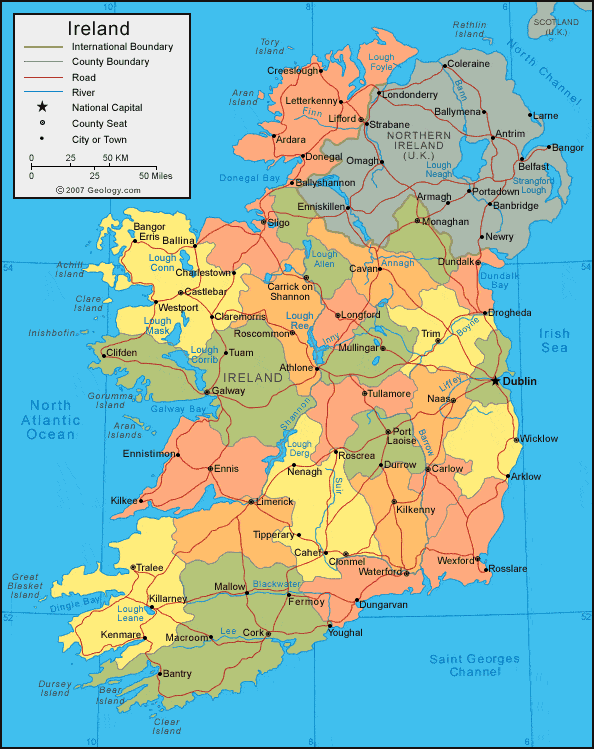 |
| From this site: “In 1896, Marconi, just 21, left Italy for England, where he hoped to drum up interest in a contraption he had invented: a box that could send Morse code signals across a room without any connecting wires. This was, quite simply, the first transmission of information by radio waves. Marconi called it “wireless telegraphy” — an improvement on the dominant technology of the day, the telegraph.” |
“Fascinating Fact of the Day About Ireland”
“Irish
weddings are elegant and large celebrations. Grooms dress in kilts that signify
their family’s clan, while brides dress in white to signify their purity.
Family members travel far and wide to attend weddings, and the receptions are
always massive celebrations involving beer and music.”
Today, we’ve included several photos of historical items we discovered at the Connemara Heritage and History Centre. The rich history of Ireland will continue during our remaining time on the island. Yes, Ireland is an island. At times we can imagine it is connected to other European countries: “Ireland is an island in the North Atlantic with Just under 4.8 million living in the Republic of Ireland and just over 1.8 million live in Northern Ireland.
 |
| The small theatre at the Connemara Heritage and History Centre where we watched a movie about Connemara. |
Northern Ireland and the Republic of Ireland are two distinct countries: “Ireland or the Republic of Ireland as it is officially named is now a completely independent country and has no longer any formal bond to the UK. On the other hand, Northern Ireland is still a part of the UK (the United Kingdom of Great Britain and Northern Ireland), together with England, Scotland and Wales.”
 |
| Items used in distilling. |
Ireland became part of the United Kingdom in 1801. The British government was forced to partition the six most northeastern counties of the new Irish state to form Northern Ireland in fear that Protestant civil unrest in Ulster would otherwise turn into a civil war against the new state.
 |
| These two glass cases contained a variety of items used in daily life in Ireland, many from centuries ago. |
Ninety years ago, Ireland was split in two after people living there went to war against their British rulers. The south became a separate state, now called the Republic of Ireland. But the break-up led to decades of unrest and violence in Northern Ireland, which remained part of the UK.

 |
| Ireland has quite a history of uprisings beginning in 1534 as listed at this link. |
Fortunately, I can readily ask him questions that arise in our day-to-day lives and gather more detailed information through online research. We both share our curiosity and desire to learn something new each day we are here.
 |
| A variety of pots, trunks, and utensils used in Irelands over the centuries. |
 |
| Connemara marble is described as follows from this site: “Connemara is bounded on three sides by the Atlantic Ocean and encompasses a wide variety of natural and semi-natural habitats, reflecting its great geomorphologic and geological complexity. It also has diverse economic resources. Among the more unusual are extensive deposits of soapstone and veins of green marble and vivid white quartz. In Neolithic times, the green marble was traded as far away as Lough Gur, County Limerick, and possibly to the Boyne Valley. ‘Connemara Marble’ is a serpentine-rich rock, popular since ancient times as a decorative facing stone. With its ‘forty shades of green’ and its wild patterns, it perfectly represents the Emerald Isle’s landscapes. Connemara Marble inspired artists, architects, and artisans throughout the world. Jewelry and other small objects such as key rings, coasters, and crosses are also made with this unique stone.” |
 |
| The first commercial telegraph station was in Ireland. |
 |
| Various tools used in fishing and farming. |
Generally, one is expected to be ambulatory after any surgery within eight weeks. I hope by continuing improving by walking which will aid in escalating the healing process.
 |
| An old sewing machine and statue of an Irish woman. |
 |
| Note the date of this poster, June 15, 1728, offering a reward for capturing two “highwaymen,” robbers who stole from travelers. |
Have a fantastic day and above all, be well.
Photo from one year ago today, May 27, 2018:
 |
| Frank and Mrs. Frank had been busy working at building a nest in the bush in our yard. But, they never had a single chick while we were there. For more photos, please click here. |













